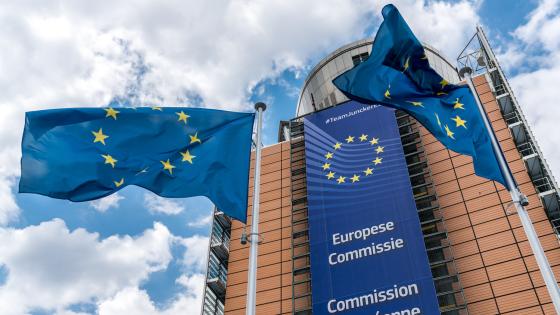Authors’ note: None of the authors is consulting for any party involved in this transaction, and none has taken payment from any party in connection to this Policy Insight. Current or recent consulting clients on matters unrelated to Google-Fitbit for those authors with such clients are ETNO (for Bourreau), Amazon, Apple, Microsoft, and multiple other firms not in the technology sector (Caffarra), Apple (Crawford), several competition authorities (Duso), clients not in the technology sector (Genakos), a competition authority and clients not in the technology sector (Heidhues), several competition authorities and a client not in the technology sector (Peitz), and a software company involved in an antitrust complaint and suppliers not active in technology markets (Vergé). A party in the Google-Fitbit matter adverse to Google is a client of CRA, but not of Caffarra. This column has also been published as CEPR Policy Insight No. 107.
Google’s mission is to monetise the world’s data – and health data is exceptionally monetisable, in ways that can directly harm consumers
Google advertises its mission as “to organise the world’s information and make it universally accessible and useful” – but its business practices of the last decade suggest a more accurate statement: “to monetise the world’s data.”
Google’s “playbook” is by now well understood. Its history of systematic acquisitions across a vast “chessboard” of disparate activities, bolted onto its original Search behemoth, are unified by a common aim: to enhance and protect its unique data empire, and enable its monetisation in ever-expanding applications. YouTube was acquired and, like Search, offered for free to consumers to be monetised by selling “audiences” to advertisers. Android was acquired and then offered for free to developers and handset manufacturers as part of a strategy to build the “bridge” that enabled the shift of Google’s search monopoly from the desktop to mobile. Like Google’s suite of popular “free” services (Gmail, Calendar, Maps, News, Chrome, etc.), it was not monetised directly through the sale of ads, but through the collection of consumer demographic, interest, and location data to better target the sale of ads. The acquisitions of Doubleclick and AdMob sealed Google’s current monopoly in ad intermediation. In addition to these high-profile acquisitions, Google has made dozens of others, mostly under the radar of competition agencies, involving multiple complementary functionalities facilitating its mission of data collection, data analysis, and exploitation. There is a term for this – “platform envelopment” (Eisenmann et al. 2011): offering convenience to consumers while throttling competition. And (as the competition authorities know well) the strategy has also involved a track record of proven anticompetitive leveraging from one market into others (from Android to Shopping to adtech).1
Monetisation of data has multiple aspects. As documented by the CMA, controlling access to vast audiences allows Google to charge higher advertising prices;2 and controlling access to unparalleled data about these audiences allows Google to carve them up according to demographics, interests and locations, and to auction them to the highest bidder. And because it operates on all sides of the ad tech stack, Google can infer advertisers’ willingness to pay and other publishers’ willingness to accept for audiences, and extract value from both. Unlike traditional monopolists, Google’s dominance does not yield just “ordinary” market power: its essence is that of a “discriminating” monopolist present across multiple markets, capable of harming consumers through personalisation of advertising and increasingly also by enabling targeted product offerings, accompanied by a record of leveraging its power both into adjacent markets and to protect its existing dominance.
This discriminatory power, supported by Google’s unmatched data, is the dimension of the proposed acquisition of Fitbit that concerns us most. The interest of Google in this deal is not in Fitbit’s wearable itself – but only in the wearable as a source of valuable complementary health metrics which Google can correlate with an enormous wealth of other data. Exploiting this data as a general-purpose input, and flexing its discriminatory power, is something Google has done (very profitably) for some time, and very openly, in online advertising markets. But such data has many more possible applications and Google has the incentive, ability, and track record to leverage its strength in data into many potential markets. There are known concerns around Google’s role in facilitating financial scams, for example, that hurt the weak and vulnerable (Financial Times 2020a). Gathering health data that can be interacted with its existing data assets adds a whole new level of concern around using a massive informational advantage to profitably exploit consumers and put employees at risk. In particular, combining health and other data allows for personalisation of offers in fields such as insurance, health, and even employment, that is incomparable and, as we argue below, absolutely not benign or efficient. Looking beyond narrow consumer welfare, an increased vulnerability of users as employees endangers the social fabric of Europe.
There is every sign that Google has made major strides to position itself to be as strong as possible in the fabulously attractive “health tech” field of applications (health and life insurance, medical services, and related services). “Health tech” is an enormous growth area where personalised offers often do not mean primarily “lower prices” to good candidates, but higher prices and – critically – lower cover to others.3 This is already happening today. But what is concerning us is the prospect of Google becoming dominant in this space, uniquely combining its existing data with that gathered from Fitbit and hobbling the ability of others to compete by exploiting in various ways its Android bottleneck.
Privacy issues amplify our concerns. GDPR rules have known limitations, but privacy issues here are intimately connected with market power issues, and we cannot just look away hoping that privacy regulators will pick up the ball. The reality is that consumers don’t know how their data is used and have limited control over it even when they do know. Changes in the way data is shared, paired with other data, and used – which Google would inevitably pursue – would represent a quality-adjusted price increase to consumers for the use of Google’s “free” services (including the historical use of their services). Furthermore, unknown privacy characteristics (like knowing how data given five years ago may be used by Google today) are analogous to “hidden prices” in the behavioural economics literature, and suggest further economic harms.
Such harms are merger-specific not because rivals will necessarily have the incentive to offer better hidden privacy options, but because rivals simply do not have remotely comparable capabilities to analyse such data – to the detriment of consumers. This also means that a data access obligation is not an adequate remedy and may lead to more consumer harm.
It is just plain wrong to say “Gmail and Chrome and Android are free”. They are not free if they permit the targeting of negative goods (addictive products, financial scams, insurance exclusions), if the costs of digital advertising (estimated by the CMA at £500/household in the UK) are passed on to consumers, or if it was poorly understood that the use of a Google product implies the data collected by them may be used forever for any use whatsoever. These data practices can already be seen as an exploitative abuse of dominance. And the prospect for consumer exploitation of this kind is in our view both direct consumer harm and implies future competitive harm that is relevant to the evaluation of a Google/Fitbit merger.
Need to look beyond the most obvious “theory of harm” in online advertising
As widely reported in the press, Google conceded at the end of the EC Phase 1 review of this matter that to the extent there was a possible concern about the use of health data gathered from Fitbit for advertising purposes, it could accept an undertaking “not” to do so.
Of course we should worry about the combination of Fitbit’s health with Google’s non-health data if this further cements Google’s already dominant position in online advertising markets. Correlating such data (e.g. demographics and/or interests with heart rate and/or sleep patterns) could well be valuable to pharmaceutical or health product suppliers interested in targeted advertising, for instance, and would enable Google to extract further value from them in search advertising. This would also mean less value for rivals (in search) and less choice for advertisers (and ultimately consumer harm). This is a key chapter of Google’s “playbook”.
But note: a promise by Google “not to use Fitbit data for advertising” would not conjure away all potential harm in any event. Leaving aside how such a promise could even be monitored, given Google’s track record, predictions need not rely on individual/personal data: due to privacy externalities, it is enough for Google to correlate aggregate health outcomes with non-health outcomes for even a subset of Fitbit users that did not opt out from some use of using their data, to then predict health outcomes (and thus ad targeting possibilities) for all non-Fitbit users (billions of them) (Choi et al., 2019; Acemoglu et al., 2020). This implies direct harm from reduced privacy/quality to consumers, higher prices to advertisers due to greater ability to discriminate, and a substantial lessening of competition (SLC) in online advertising markets.4
Other theories of harm are of even greater concern
The essential concern around this deal is the way that it enables Google to implement conduct that will strengthen its ability to gather and exploit health data, and undermine the ability of rivals to do so, in order to leverage its power into health and insurance markets. This involves various combinations of strategies that are intended to expand the adoption of Fitbit over other wearables (through pricing and tying and other means) so as to enhance data collection (both health data and general mobile device data); and leverage Google’s control over the Android operating system – which wearable manufacturers require for tethering the wearable to users’ smartphones – by making their access to Android contingent on terms that restrict their ability to use data from their users (or force them to share it with Google). The harm (which is merger-specific) is the creation of additional power in health and insurance markets (among others), foreclosure of actual and potential rivals in these markets by undermining their ability to compete, and directly exploiting consumers by extracting surplus from them (in addition to exposing them to a reduction in the quality of the service by using the data in ways they do not consent to and are indeed not even not aware of).
The starting point needs to be an appreciation that “health tech” (the use of data and AI to finely discriminate on the basis of user profiles and health data to predict health outcomes and personalise offers) is already a $100 billion business and one that is predicted to be a major area of growth in the future.5 There is enormous money to be made by selling sophisticated analytics to health providers and insurers that enable them to identify risk and price it accordingly. A wearable is a generator of a constant stream of health-related signals that is then related to an app on users’ smartphones, and from there sent on to the cloud where it can be analysed. Wearables are also increasingly featuring non-health apps – from maps to music – with screens becoming bigger and incorporating voice-activated commands. At present, in “Android space” (i.e. outside of Apple’s ecosystem) there are multiple significant wearable manufacturers and a large range of health analytics providers, all involved in investing and positioning for this future. The enormous potential of these applications has certainly not been lost on Google, which has already taken multiple steps to position itself as a major player in health and insurance.6 This deal has the potential to tip the scale in its favour in ways that are not retrievable given Google’s other advantages, and extend its hold on sensitive and critical data into an area which touches us all. We see three potential theories:
First, Google has the incentive and ability to favour the adoption of Fitbit over rival wearables on the user side, and to simultaneously undermine the ability of others to offer competing products to insurers and health providers. The concern is (partial) foreclosure of rival wearable manufacturers, and of other operators in the supply chain that rely on data for the sale of analytics to health providers and insurers. On the user side, Google can adopt multiple strategies that would directly favour the adoption of Fitbit over rival wearables – such as selling the wearable at below-cost price because it can recoup in multiple ways elsewhere that are not replicable by others; or entering into agreements with insurers and health providers to give their customers incentives to use Fitbit in exchange for other benefits (for instance, conditioning benefits and premia to the insured adopting certain behaviours – already standard in health insurance markets). As to rival wearable manufacturers, the concern is that Google will have the incentive and ability to hobble their ability to compete in health data applications, not only by directly “pushing” the adoption of Fitbit with users and health providers/insurers, but also indirectly by degrading the interoperability of dominant Google-owned complements on which other manufacturers rely. Wearables manufacturers particularly rely on Android functionalities for connecting the wearable to the smartphone, and for multiple other purposes; they also need to be allowed to place their app into the Play Store. Those Android capabilities that are currently open source could be restricted in the future, post-deal, and interoperability could be degraded in multiple ways. Google could also or alternatively require compensation from rival wearables manufacturers/health data competitors in order to maintain interoperability. This “compensation” could take the form of demanding access to their own health data, collected from users of their wearables, or placing restrictions on rivals’ use of data in health applications.
Second, what is unique about this deal is that the Fitbit datastream would be bolted on top of Google’s own “data firehose” and unrivalled stock of cumulated data on multiple aspect of users’ profiles. The interaction of health and non-health data can be used to make enormous profits in health and insurance markets, directly (to the extent that Google offers these services itself) or indirectly (to the extent that it sells these insights and analytics to actors in these markets). Google’s dominance in non-health data, combined with health data, will enable them to uniquely identify good risks and extract surplus from them (e.g. offering them only slightly lower prices), causing higher prices or lack of cover for bad risks and, in the extreme case, market unravelling over time.
It is precisely Google’s dominance in non-health data which indeed counters the efficiency gains from the entry of Google into health data markets: if non-health data like that controlled by Google were widely held and firms competed on that basis, then we could imagine competitive benefits. Instead, the entry of a dominant discriminating (data) monopolist into insurance markets will not yield price benefits to consumers in these markets; it will just extract consumers’ surplus. This direct consumer harm would be reinforced by an SLC as Google’s non-health data advantage is durable, particularly if health data applications themselves have any factors that encourage concentration in the long run (as is likely the case in big data applications).7 Wearables providers are now on a roughly equivalent footing in that none has the non-health data that Google has; allowing Google to leverage its non-health data dominance into health data applications will cause price increases, quality reductions and direct customer harm from discrimination. This can be also purposed as an SLC as potential future competition is undermined due to Google’s durable competitive advantage and (possibly) the increasing-returns structure of health data applications markets.
As an additional dimension, while we have focused so far on health data and its applications, it also is widely known that based on a consumer’s browsing history and app use, Google can already predict personal characteristics many users would strongly prefer to remain private.8 Combining health data with non-health data is likely to improve the ability to make such predictions (for example, using the time of night, your heart rate, and locations from multiple Android phones to predict whether you are having sex and with whom) and nothing would prevent Google from using such predictions for any application. There are already growing concerns about AI being used to inform sensitive financial services and insurance decisions; imagine it being used for employment or selective entrance decisions. We consider this an unknown future (hidden) price increase of the merger which again causes both direct consumer harm and, if profitable, an SLC in the affected markets since no other firms will have comparable non-health data.
Third, there is a clear theory of harm centred around dynamic foreclosure considerations in wearables operating systems. In addition to the value wearables may have for health data applications, they are also likely to be a particularly important market for the dynamic evolution of competition in digital markets more generally. This is because they are a potential new access point for consumers to the Internet, particularly as voice-recognition technology continues to develop. Because wearables are a potentially important new source of consumer attention, Google would have the incentive and ability to favour its Wear OS operating system for all (non-Apple) wearables in a “defensive” leveraging strategy: such a strategy would not only protect its current dominance in demographic, interest, and location data from a rival that developed a widely adopted wearable operating system, but could also protect Android from a potential entrant into mobile device (smartphone and tablet) operating systems.9 Foreclosure strategies are particularly likely to be effective in operating system markets, as they exhibit network effects and are likely to tip to a small number of providers (as they have done for mobile phones with iOS and Android).10 The analogy to the Microsoft/Netscape case is clear: accounting for the likely dynamic evolution of the wearables market, this isn’t just a merger of complements!
Evidence for these theories of harm
Competition authorities are of course best placed to directly interrogate Google’s internal documents and probe the evidence of third-party wearable manufacturers, health data providers, and other actors in the supply chain concerned by this merger. While we do not have direct evidence to offer, we would nonetheless point to two important dimensions.
First, it is unquestionable that “health tech” is recognised as a major area of future application for data and AI, in which there are enormous profits to be made. Personalisation is acknowledged as the future of the health care industry and it is already present and growing in the insurance industry. The “wearable devices” market alone is projected to grow to over one billion connected devices by 2022.11 But the wearables market is not the real “prize”. And it does not matter that Fitbit is currently a small piece of this market; it is valuable because it provides Google with a toehold in wearables from which to leverage a more ambitious strategy of expanding in the giant potential of health tech – combining sensitive health data with the personal profiles of users collated from other services.
Google has indeed taken multiple steps already to position itself in this massive growth area: it established Google Health (a repository of health records and data intent on developing a specific search engine for medical records), it established Project Nightingale (a secretive joint project by Google Cloud and Ascension, a large private healthcare system in the US, which collates enormous medical records on millions of citizens), it acquired Deepmind (health data analytics), it partnered with Mayo Clinic and other hospitals and healthcare providers to view and analyse millions of patient records, and it owns subsidiaries Verily and Calico with a focus on research in life sciences and health and wellbeing.12 Indeed Verily just announced that that it will begin itself to offer insurance (Peters, 2020). Billions have been invested by Google’s venture capital arm, GV, in health care and life sciences. The combination of these assets with Google’s cloud power and AI already make abundantly clear that this should be one of the main focuses of the assessment of this deal. Fitbit is one more essential piece in this puzzle: it provides the capability of harvesting health data directly, and at the same time of undermining rivals’ progress (not necessarily Apple’s, but “owning” the space of manufacturers that must connect to Android mobile devices would be good enough). There can be little doubt that the opportunity available in health tech dwarfs the size of the wearables market.
Second, inspired directly by this deal, academic research is beginning to emerge offering analytical support to the concerns we have outlined here. As briefly mentioned above, a new paper by Chen et al. (2020) models the effects of a data-driven merger between two firms respectively operating in a market A for data applications (health care) and a market B for data collection (wearables).13 There are cross-market complementarities in that the data generated in market B can be used in market A for personalisation of offers that match better with consumers’ tastes. However, the extra consumer surplus created by such personalisation can be extracted by the merged entity through personalised pricing (price discrimination). A merger between firms operating in each market creates a merged firm C with market power, and the authors identify two anticompetitive effects from personalisation: exploitation of consumers through extraction of consumer surplus above the outside option, and market foreclosure as “the merged entity is secured a large base of non-contestable consumers under personalisation and will compete aggressively for contestable consumers”. While there may be some circumstances in which the benefit of more aggressive competition for consumers can offset the harm and total surplus can increase, this competition-intensifying effect is a by-product of market foreclosure, which could ultimately harm consumers in the long run. Moreover, Chen et al. found that the merger would link the market for wearables and the market for health care together, through which Google could leverage its market power and foreclose competitors in both markets. This directly formalises some of the types of effects we are describing, and this contribution is important as it illustrates that these concerns can be also formally articulated.
Furthermore, the negative effects formalised in Chen et al. (2020) arise in a model in which superior data does not allow firms to better predict a consumer’s risk class, and in which consumers and firms are equally good at predicting likely future health problems. Following the merger, however, it may be often the case that Google/Fitbit can better predict what diseases a consumer is likely to develop than the consumer herself. Google/Fitbit could use this information to the further detriment of consumers by selling the information about which consumers have the lowest risks of developing costly health conditions. This would cause the deterioration of the functioning of health insurance markets as competitors will tend to face worse risks on average, and hence offer worse deals (enabling Google to collect even more money from its information advantage). And, since selecting a health insurance plan is extremely difficult and a large body of existing academic work documents that consumers make a number of mistakes when doing so (Chandra et al., 2019), a more realistic consumer model should allow for limited attention of or mistakes by consumers. In such a case, Google/Fitbit is likely to enable insurance companies to exploit their informational advantage over consumers through offering personalised contracts that exclude exactly those costly services that the consumer will need with higher than average probability. Such “exploitative tricks” will likely further deteriorate the functioning of insurance markets to the detriment of consumers and competition.
Some reflections on remedies
A decision to block the merger would preserve the current playing field among wearable manufacturers and health data providers and protect consumers from exploitation and a reduction in competition due to the combination of non-health with sensitive health data.
We acknowledge that a prohibition, and even remedies, may well imply that certain innovations by Google are foregone as a result. We recognise of course that mergers involving data can have beneficial effects, as firms can better tailor their products and personalise their offerings and can foster data-driven innovation by the merging parties. But Google is not just “anyone”. It is arguably dominant in non-health data as well as multiple related product markets and has a track record of leveraging that dominance. Putting a break on Google’s ambitions in this space is, in our view, the price one should be willing to pay for the prospect of more innovation over time from others (as well as less consumer exploitation). Authorities have dealt with these tradeoffs before – from the original Microsoft case, where Microsoft’s argument was that any intervention would amount to expropriation of its IP and was going to kill all innovation. The reality is that competition drives innovation in most settings.14 This is the view the European Commission has taken in multiple mergers too (Dow/Dupont to quote but one), where the loss of future competition and innovation was a material concern.
The difficulty of designing a suitable package of remedies becomes apparent once one starts to think of what solutions could be adopted and whether they would work. Press reports indicate that the Commission “is poised to approve” the deal subject to remedies, the most important of which include (1) a promise not to use Fitbit’s health data for online advertising for ten years; (2) a requirement granting other wearable manufacturers access to Fitbit’s health data (subject to user consent), on the same terms as Google; and (3) a commitment that rival wearable manufacturers would not be hindered from using Google’s Android and cloud platforms (Financial Times 2020b).
Based on our review of likely consumer harms from the transaction, short of a prohibition we see the need for remedies that are both extensive and detailed, with a big question mark over the scope for circumvention and how they would be policed in practice. For example, to address the exploitation theories of harm described above, minimal commitments should include:
- Data use restrictions (not just “data silos”) (a) preventing the combination of health data with any characterisation of Google’s non-health data for use in online advertising, but also (b) requiring that Google’s existing non-health data is only used for online advertising unrelated to health products and services, employment, and any other product or services for which there are particularly strong concerns about consumer exploitation and/or market unravelling (e.g. financial services). While a (weak) version of this commitment appears to have been offered by Google, much detail would need to be worked through to make it meaningful and to avoid circumvention. A sector regulator (not in existence) or a trustee would likely be needed to constantly monitor ongoing compliance.
- Data use restrictions (c) preventing the combination of health data with any characterisation of Google’s non-health data in health data and insurance markets, but also (d) requiring that Google can only use Fitbit data for health data and insurance applications. We do not see this in the list of remedies for consideration at present. Such a restriction would prohibit Google from using health data together with non-health data to sell – directly or indirectly – risk profiles to insurance companies or offer health or other types of insurance itself. In effect, this would impose an “inverse-HIPAA” protection on Google’s non-health data and say that it may not be used for health data applications.15 Furthermore, if health data were permitted to be used by itself in insurance markets, a requirement should be set that it not be used to exclude components of coverage that consumers may value (e.g. based on predictions of future illness). Again, data use restrictions would require monitoring and, thus, a sector regulator with the power to immediately intervene.
- Require consumer-friendly privacy practices. Many of the exploitation harms we are concerned about could be partially mediated by granting consumers much greater control over the use of their data. Examples here would include (but need not be limited to) (e) mandating the ability of consumers to opt out of targeted advertising, (f) mandating the ability of consumers to opt out of targeted insurance, (g) mandating that Google provide consumers the right to be forgotten across all non-health and health data, and (h) mandating consumers be asked (e), (f), and (g) on a regular (e.g. annual) basis with privacy-friendly defaults. For example, the default consumer privacy setting should be that data is not used for targeting advertisements or health offers, and that use of a service is not conditioned on the choice. Google should furthermore be required to document that consumers were making an informed choice with respect to targeting.
To address the foreclosure theories of harm described above, it is very hard to enumerate all the many ways Google could foreclose rival wearable manufacturers and/or rival wearable operating systems. Two general principles should be that Google should be forbidden from agreeing to exclusive deals in any market which impacts the wearables or wearable operating systems markets, and to require interoperability on FRAND terms equivalent to that which Google grants its own services in related markets.16 Minimal commitments that embody these principles include (but need not be limited to):
- Interoperability and FRAND access not only to Android and Google Cloud APIs, but to APIs for all Google products and services for which Google has a more than minimal market share (e.g. Play Store, Maps, Calendar, Chrome, etc.). This commitment seeks to prevent Google from leveraging their dominance in one of its many related product markets into the wearables market. It is probably feasible to formulate this as there are precedents: one could mandate comparable interoperability between rivals’ OS and all Google’s dominant apps as Google has with its own Wear OS. However, absent remedies on data use described above, this appears unlikely to prevent Google from leveraging its dominant position in non-health data into the market for wearables and, more importantly, associated health data markets.
The next commitments seek to prevent some of the many ways that Google may seek to distort competition in the wearables and/or wearables operating system markets. Each practice would give Google an advantage in both the wearables (and thus health data) and wearables operating system (and thus health and non-health data) markets. Minimal commitments include (but need not be limited to):
- Prohibition of below-cost pricing for wearables. This commitment would be very difficult to monitor given the difficulties of calculating the relevant cost. Also, it would not necessarily be effective since even marginal cost pricing (or low margins) can also endanger competitors that face fixed costs for their investments in quality.
- Prohibition of tying strategies involving Fitbit and insurers/health providers – for instance, prohibiting Google from offering deals to insurance companies or healthcare providers conditional on them pushing Fitbit onto their customers or patients. Again, the difficulties of monitoring this commitment seem enormous. Tying is a major part of Google’s playbook and circumvention of a prohibition is always somehow possible (see, for example, Google’s response to the Android remedies).
- Prohibition of exclusive deals with major rival wearable manufacturers that disadvantage rival wearable OS providers (à la Apple and Google Search). This has the advantage of being feasible and easily monitorable.
Conclusion
The Google/Fitbit merger provides the chance for the European Commission to remain a front runner in enforcement and indeed guide merger policy in the digital era. While some remedies are conceivable that can mitigate the risks to competition and long-run consumer harm, they are complex, at risk of circumvention in multiple dimensions, and will continue to require constant monitoring. This cannot be the preferred road to take even if a proper regulatory structure were already in place. The ex-post consequences of failing to prevent a harmful combination in digital markets have been documented time and time again, and there is a widely held consensus that given the difficulties of “unscrambling the eggs” over time, the only principled approach to merger control in this space is to prevent harmful mergers from being consummated. All too often, academics and policymakers look back and lament a failure to intervene more decisively, and bemoan their hopeful reliance on remedies that just do not work. As we have argued, the acquisition of Fitbit is not just about one more gadget being brought into Google’s ecosystem, but one involving highly sensitive data that is likely to harm consumers in health insurance, medical services and even labour markets and protect Google’s dominant position in demographic, interest, and location data. Blocking the merger does not solve all problems related to health data, but it avoids amplifying already existing problems. A bad merger with bad remedies remains a bad merger for society.
References
ACCC (2019), Digital Platforms Inquiry Final Report, 26 July.
Acemoglu, D, A Makhoumi, A Malekian and A Ozdaglar (2020), “Too much Data: Prices and inefficiencies in data markets”, NBER Working Paper No. 26296.
Chandra, A, B Handel and J Schwartzstein (2019), “Behavioral economics and health-care markets”, in Handbook of Behavioral Economics: Applications and Foundations 1, Volume 2, pp. 459-502.
Chen, Z, C Choe, J Cong and N Matsushima (2020), “Data driven mergers and personalization”, Working paper, 26 September.
Choi, J, D-S Jeon and B-C Shin (2019), “Privacy and personal data collection with information externalities”, Journal of Public Economics 173: 113-124;
CMA (2020), Online Platforms and Digital Advertising, Market Study Final Report, 3 July.
Crémer, J, Y-A de Montjoye and H Schweitzer (2019), Competition policy for the digital era, report for EC DG Competition, April.
Day, R and P Nadash (2012), “New state insurance exchanges should follow the example of Massachusetts by simplifying choices among health plans”, Health Affairs 31(5).
Eisenmann, T, G Parker and M Van Alstyne (2011), “Platform Envelopment”, Strategic Management Journal 32(12): 1270–1285.
European Commission (2017), Decision Case AT.39740 (“Google Search (Shopping)”), released 27 June. European Commission (2018), Decision Case AT.40099 (“Google Android”), released 18 July.
Federico, G, F Scott Morton and C Shapiro (2019), “Antitrust and Innovation: Welcoming and Protecting Disruption”.
Financial Times (2020a), “UK regulator says Google not doing enough about scam ads”, 24 September.
Financial Times (2020b), “EU poised to clear $2.1bn Google Fitbit deal after new promises”, 29 September.
HM Treasury (2019), Unlocking Digital Competition, Report of the (UK) Digital Competition Expert Panel, March.
Peters, J (2020), “Verily, Google’s health-focused sister company, is getting into insurance”, TheVerge.com, 25 August.
Ryan, J (2020), “Two years on from complaint to the Irish Data Protection Commission, the RTB [Real-Time Bidding] data breach is the largest ever recorded, and appears to have worsened”, Irish Council for Civil Liberties submission to the Irish Data Protection Commissioner, 21 September.
Stigler Committee on Digital Platforms (2019), Final Report, July.
Wen, W and F Zhu (2019), “Threat of Platform-Owner Entry and Complementor Responses: Evidence from the Mobile App Market”, Strategic Management Journal 40(9): 1336–1367.
Endnotes
1 See European Commission (2017, 2018), CMA (2020) and multiple others.
2 CMA (2020) reports that Google commands prices for search keywords 30-40% higher than that earned by Bing, and that they earn a return on capital in excess of 40%.
3 Furthermore, acknowledging that consumers have limited attention or ability to foresee future medical conditions, Google would have an incentive to use its superior knowledge to sell or enable others to sell secretly degraded insurance options whose coverage exempts medical conditions likely to be important for the consumer (Day and Nadash, 2012). In addition to direct consumer harm, this has the potential to significantly harm the functioning of health insurance markets, with similar concerns arising in other applications.
4 Note that the last two effects are distinct: the SLC is an increase in market power, and the discrimination is a more efficient exercise of an existing level of market power.
5 See Appendix C in Chen et al. (2020) for a concise summary of Big Data Analytics (BDA) and personalisation in health care. They show there, for example, that almost 50% of insurance providers already use BDA for pricing and underwriting and that this will grow to 70% in the next three years.
6 See Appendix B in Chen et al. (2020).
7 As motivated by Chen et. al. (2020), it is common in big data for there to be a positive feedback loop: firms with larger/more comprehensive data sets can offer better-targeted products thanks to data-enabled learning, attracting more customers, and accumulating ever more data.
8 See, for example, Ryan (2020). The submission documents that advertisers may search for people who regularly visit websites related to “Substance abuse,” “Diabetes,” and “Chronic pain.” Data brokers further allow targeting based on a host of other intimate details, including religious beliefs.
9 It would also serve as an “offensive” leveraging strategy to collect health data from wearables manufactured by rivals.
10 These points have been made across a host of reports analyzing the status of competition policy (including merger review) in digital markets, including ACCC (2019), HM Treasury (2019), Crémer et al. (2019), and Stigler Committee on Digital Platforms (2019).
11 https://www.statista.com/statistics/490231/wearable-devices-worldwide-by-region/
12 See again Appendix B of Chen et al. (2020) for a concise summary of Google’s ambitions in health care.
13 Op cit.
14 See, among many, Federico et al. (2019). In an empirical investigation, it has been found that app developers reduce innovation efforts and increase prices of apps threatened by entry from Google (Wen and Zhu, 2019).
15 In the US, HIPAA is a 1996 law establishing standards to protect sensitive patient information. Among other things, it limits the use of patient’s protected health information for treatment, payment, and healthcare operations.
16 FRAND = fair, reasonable, and non-discriminatory. FRAND terms and conditions are commonly used in regulatory and antitrust environments.




















